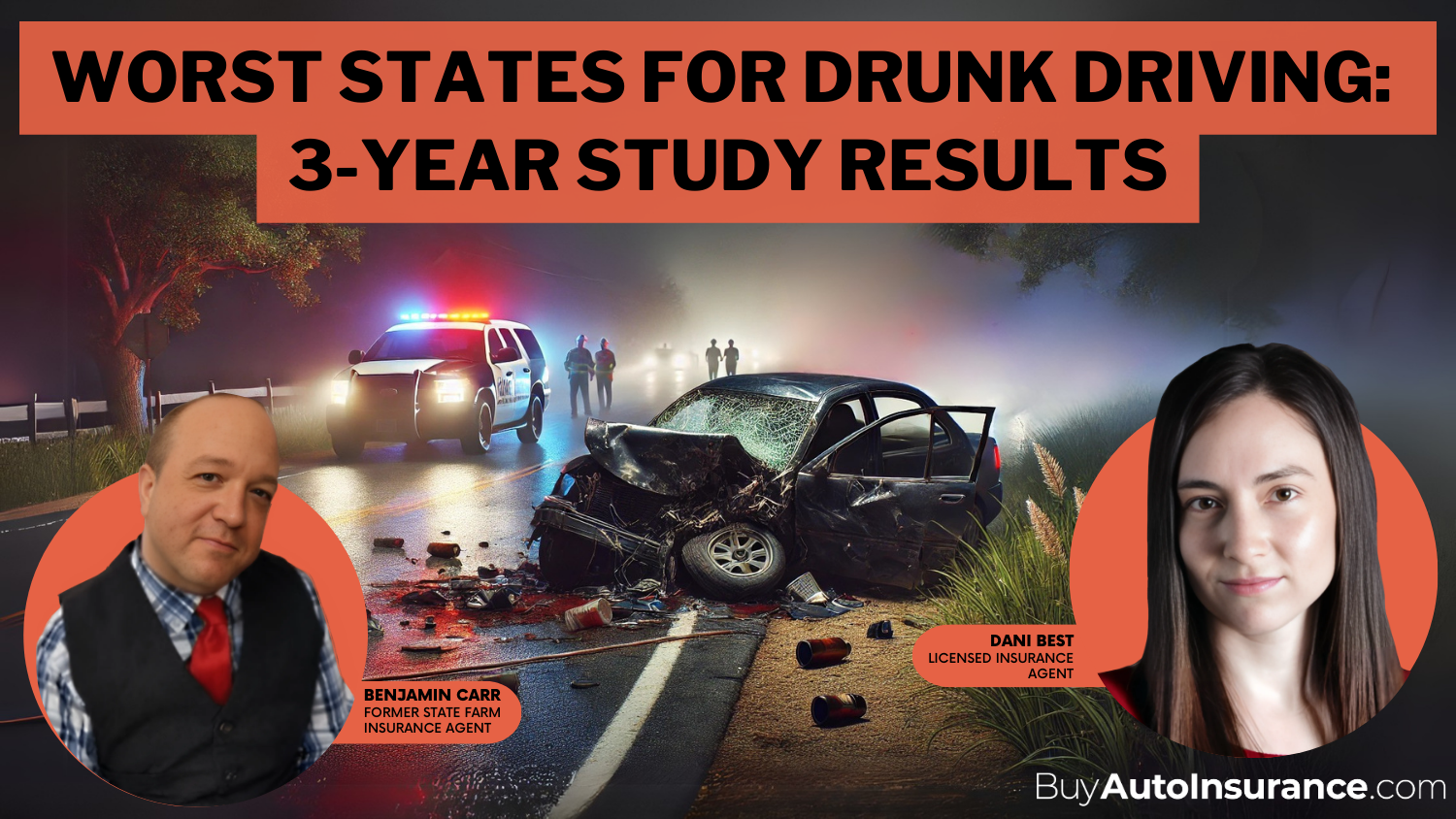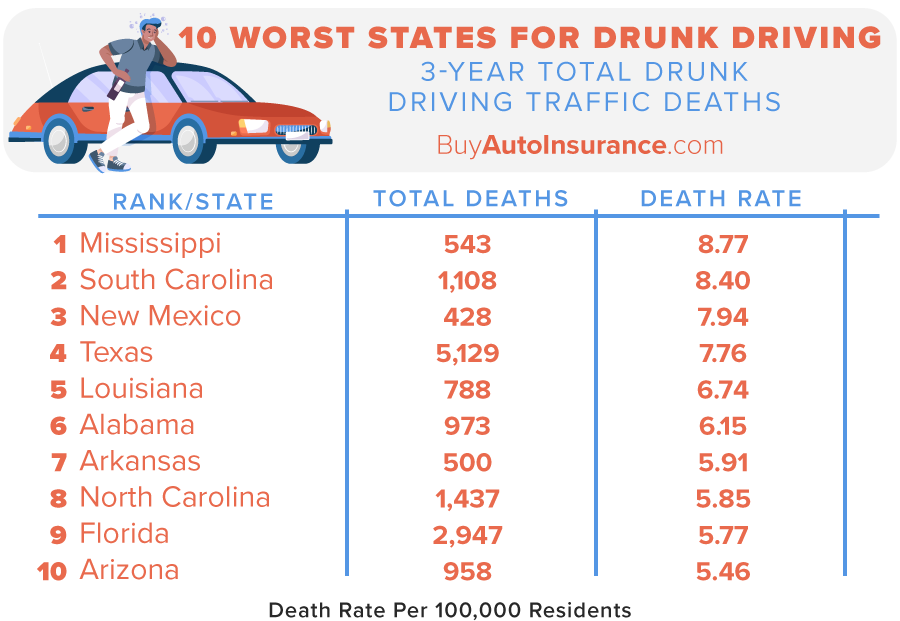10 Worst States for Drunk Driving [3-Year Study]
The 10 worst states for drunk driving have an average of 6.8 traffic deaths caused by a drunk driver for every 100,000 residents. Eight out of the top 10 worst states for drunk driving are located in the South, with the other two in the West. While the national number of drunk driving traffic deaths declined during our three-year study period, three of the 10 worst states for drunk driving saw increases in traffic fatalities involving a driver impaired by alcohol. The deadliest state for drunk driving is Mississippi with 543 alcohol-related traffic deaths during our study period.
Read more
Free Car Insurance Comparison
Compare Quotes From Top Companies and Save
Secured with SHA-256 Encryption
Dani Best
Licensed Insurance Producer
Dani Best has been a licensed insurance producer for nearly 10 years. Dani began her insurance career in a sales role with State Farm in 2014. During her time in sales, she graduated with her Bachelors in Psychology from Capella University and is currently earning her Masters in Marriage and Family Therapy. Since 2014, Dani has held and maintains licenses in Life, Disability, Property, and Casualt...
Licensed Insurance Producer
UPDATED: Mar 26, 2025
It’s all about you. We want to help you make the right coverage choices.
Advertiser Disclosure: We strive to help you make confident auto insurance decisions. Comparison shopping should be easy. We are not affiliated with any one auto insurance provider and cannot guarantee quotes from any single provider. Our auto insurance industry partnerships don’t influence our content. Our opinions are our own. To compare quotes from many different auto insurance companies please enter your ZIP code on this page to use the free quote tool. The more quotes you compare, the more chances to save.
Editorial Guidelines: We are a free online resource for anyone interested in learning more about auto insurance. Our goal is to be an objective, third-party resource for everything auto insurance related. We update our site regularly, and all content is reviewed by auto insurance experts.
UPDATED: Mar 26, 2025
It’s all about you. We want to help you make the right coverage choices.
Advertiser Disclosure: We strive to help you make confident auto insurance decisions. Comparison shopping should be easy. We are not affiliated with any one auto insurance provider and cannot guarantee quotes from any single provider. Our auto insurance industry partnerships don’t influence our content. Our opinions are our own. To compare quotes from many different auto insurance companies please enter your ZIP code on this page to use the free quote tool. The more quotes you compare, the more chances to save.
On This Page
- Nationally, drunk driving traffic deaths dropped 4.3% during our study period
- Three of the 10 worst states saw an increase in drunk driving traffic deaths
- The South and West were the worst regions for drunk driving
- The Midwest and Northeast were the best regions for drunk driving
Drunk driving is one of the leading causes of traffic deaths across America and has been for decades. It always seems regardless of national or state campaigns to deter drunk driving, the problem remains.
Drunk driving is a more serious issue in some states more than others. This article covers the 10 worst states for drunk driving based on a three-year statistical analysis.
After we go through the ranking, we’ll cover what state has the lowest number of drunk driving deaths, which state has the lowest rate of deaths involving a drunk driver, the record for most DUIs by one person, and where most drunk driving accidents occur.
Drunk driving arrests can lead to spikes in auto insurance rates or put you at risk of having to buy high-risk auto insurance. That’s just one of many financial penalties drunk drivers face, no matter which state they get arrested in.
If you’ve been convicted of a DUI, it’s likely — whether you have to get high-risk auto insurance or not — that your auto insurance rates will go up. Fortunately, there are still ways to save. One of those is to compare live auto insurance quotes from different companies.
Enter your ZIP code into our free online quote comparison tool to do just that and receive quotes personalized for your insurance and financial needs.
Now, let’s get started.
The States With Highest Drunk Driving Death Rate
These states are the worst of the worst, the 10 that have the most problems with drunk driving. Four have three-year cumulative drunk driving traffic deaths totals of over 1,000, with the highest single state total at 5,129.
All of them average 5.46 drunk driving traffic deaths per capita (100,000 residents) or higher. Beware these states — many of them rank horribly for other categories like speeding and careless driving.
Scroll down to see the 10 worst states for drunk driving.
#10 – Arizona
- 3-Year Total Drunk Driving Traffic Deaths: 958
- Drunk Driving Deaths Per 100k Residents: 5.46
Arizona comes in 10th in our ranking with a drunk driving traffic death total of 958 and 5.46 drunk driving deaths per 100,000 state residents.
This is even the case though Arizona is a zero-tolerance state, meaning you can be arrested for a DUI even if your BAC is under the .08 limit. If you have a driver’s license in Arizona, you automatically have given your consent to have blood drawn or forced to take a breathalyzer.
#9 – Florida
- 3-Year Total Drunk Driving Traffic Deaths: 2,947
- Drunk Driving Deaths Per 100k Residents: 5.77
Florida, ranking 9th, has a total of 2,947 drunk driving traffic deaths and 5.77 drunk driving deaths per capita.
The BAC limit in Florida is .08 and if you are arrested, you could face jail time, court costs, lawyer fees, vehicle impoundment, license suspension, and the placement of an ignition interlock device to make sure you’re sober before driving.
#8 – North Carolina
- 3-Year Total Drunk Driving Traffic Deaths: 1,437
- Drunk Driving Deaths Per 100k Residents: 5.85
Ranking 8th in our study, North Carolina has a drunk driving traffic death total of 1,437 and 5.85 drunk driving deaths per 100,000 residents.
There are two separate BAC limits for a regular driver versus a commercial driver in North Carolina. For a regular driver, the BAC limit is .08, while the BAC limit for a commercial driver is .04.
These types of distinctions are important and very helpful for people to know even when starting out driving, such as being taught in a driver’s ed course.
#7 – Arkansas
- 3-Year Total Drunk Driving Traffic Deaths: 500
- Drunk Driving Deaths Per 100k Residents: 5.91
Arkansas, ranking 7th, has 500 total drunk driving traffic deaths and a per capita drunk driving death rate of 5.91.
First-time DUI offenders in Arkansas face up to one year in jail and a fine between $150 and $1,000. However, if there was a person under 16 years of age in the car, the person must serve at least seven days in jail.
#6 – Alabama
- 3-Year Total Drunk Driving Traffic Deaths: 973
- Drunk Driving Deaths Per 100k Residents: 6.15
Listed 6th in our study, Alabama has a total of 973 drunk driving traffic deaths and 6.15 drunk driving deaths per 100,000 state residents.
Drunk drivers in Alabama are required to attend a mandatory DUI or substance abuse program in addition to the fines and imprisonment that drunk drivers have in other states.
Drunk driving is one of the very real dangers that make nighttime driving the most dangerous time to drive. There is a doubled effect if you’re drunk and drowsy or fatigued, adding to the dangers of driving at night.
#5 – Louisiana
- 3-Year Total Drunk Driving Traffic Deaths: 788
- Drunk Driving Deaths Per 100k Residents: 6.74
Lousiana, ranking 5th out of the worst states for drunk driving, has a total of 788 drunk driving traffic deaths and a per capita drunk driving death rate of 6.74.
Lousiana has a tiered system of punishments for DUI, depending on the level of BAC in the drunk driver. If the drunk driver has a BAC of .20 or above, they face more severe punishments, such as higher fines and a two-year’s driver’s license suspension.
#4 – Texas
- 3-Year Total Drunk Driving Traffic Deaths: 5,129
- Drunk Driving Deaths Per 100k Residents: 7.76
Coming in 4th, Texas has a total of 5,129 drunk driving traffic deaths and 7.76 drunk driving deaths per 100,000 residents.
A first offense DWI in Texas carries a maximum fine of $2,000 and a jail sentence of up to 180 days. For travelers, it’s important to know that Texas has four cities ranked in the 10 Worst Cities for Drunk Driving: Austin (2), El Paso (3), San Antonio (4), and Houston (5). Be aware while driving through these cities, especially at night.
DWIs can have a major impact on the type of car insurance you can purchase. In many situations, auto insurance companies will drop you after a DWI, forcing you to receive car insurance in the secondary market. The key term in this situation is SR-22 insurance after a suspended license. You’ll be labeled a high-risk driver, which will cause your insurance rates to rise.
#3 – New Mexico
- 3-Year Total Drunk Driving Traffic Deaths: 428
- Drunk Driving Deaths Per 100k Residents: 7.94
New Mexico, listed 3rd worst out of all states for drunk driving, has 428 total drunk driving traffic deaths and a per capita drunk driving death rate of 7.94.
New Mexico has three separate limits for a DUI. If a person is above the age of 21, they can be arrested if they have a BAC of .08 or higher. If the person is under the age of 21, the BAC level is .02. And if the driver is operating a commercial vehicle, the limit is .04.
#2 – South Carolina
- 3-Year Total Drunk Driving Traffic Deaths: 1,108
- Drunk Driving Deaths Per 100k Residents: 8.40
Ranking 2nd, South Carolina has a total of 1,108 drunk driving deaths and a drunk driving death rate of 8.4 per 100,000 residents.
South Carolina faces additional challenges that play into drunk driving death totals: a high number of speeding deaths, careless driving deaths, and choppy roads that make driving more dangerous.
#1 – Mississippi
- 3-Year Total Drunk Driving Traffic Deaths: 543
- Drunk Driving Deaths Per 100k Residents: 8.77
The worst state for drunk driving in America is Mississippi with 543 drunk driving traffic deaths and a per capita drunk driving death rate of 8.77.
The penalties in Mississippi for a drunk driving conviction are lighter than in other states, possibly contributing to the number of deaths and number of deaths per capita.
First-time offenders get hit with a fine between $250 and $1,000 but just 48 hours in jail. In addition, they receive a license suspension of just between 30 and 90 days.
Mississippi is also just one of 11 states that don’t use a point system to restrict or suspend your license. The other 39 states do use license point systems for determining some of the consequences of dangerous driving. DUIs are very costly in these systems and can result in your license being suspended for much longer than 90 days.
Compare Quotes From Top Companies and Save
Secured with SHA-256 Encryption
Deadly Trends Among the Worst States for Drunk Driving
When looking at the trends for the 10 worst states, we compared the percentage change of drunk driving traffic deaths for each state in the worst 10 to the national total for the same three-year time period.
Nationally, during our study, drunk driving traffic deaths dropped by 4.3%. The good news for the 10 worst states is that drunk driving traffic deaths declined in five of the states more than the national average:
- Florida: 6.8%
- Alabama: 18.7%
- Louisiana: 8.1%
- New Mexico: 6.8%
- South Carolina: 18.5%
Furthermore, two states also saw declines in the number of drunk driving traffic deaths, though not more than the national decline:
- North Carolina: 2.8%
- Texas: 3.6%
Three states actually saw increases in the number of drunk driving traffic deaths, even as the national number declined:
- Arizona: 11%
- Arkansas: 4.9%
- Alabama: 19.3%
For Arizona and Alabama, those are huge bursts in the number of drunk driving traffic deaths and indicate a problem that needs to be solved quickly either through government campaigns, interventions, or harsher punishments.
But it is good news that most of the 10 worst states for drunk driving actually experienced declines in the number of drunk driving traffic deaths.
Nationwide Drunk Driving Problems Analyzed
If your state did not appear on the list of the 10 worst states for drunk driving, you might be curious as to where it stands. The graph below shows all 50 states with their rankings, cumulative drunk driving traffic death totals, and drunk driving traffic death per capita numbers.
The graph is interactive: Hold your cursor over a state (if you’re on a desktop computer or a laptop) or press down with your finger (if you’re on mobile or a tablet) to see that state’s statistics.
The big conclusion is that the South and West struggle the most with this issue while the Midwest and Northeast fare the best.
The South and the West routinely dominate lists of the worst drivers in the United States, whereas the Midwest and Northeast tend to be the two best regions, so this is not necessarily a surprise.
You might be wondering, “Does auto insurance cover DUI accidents?” If you are involved in an accident while driving drunk, it’s likely your car insurance company will fight to not pay you for any damages. And they are likely to win because you were found breaking the law.
Ways States Can Combat Drunk Driving
The statistics about drunk driving are mindblowing:
- The average drunk driver drives over 80 times before being arrested
- Drunk driving results in over 1,000 children deaths per year
- Drunk driving causes over 10,000 traffic deaths per year
Utah has been the first state to try to combat this issue further by lowering its legal BAC level to .05, which is the equivalent of half a basic beer. In turn, they’ve seen a drop in DUI arrests and haven’t noticed a drop in tourism.
Dropping the legal BAC level to .05 in other states that are less conservative may be a tough sell, however.
Possibly the biggest development in deterring drunk driving is actually new technology and rideshare companies.
When it costs $10 to take an Uber home, there should be little incentive to drive drunk. But there is still more work to be done, especially in the 10 worst states for drunk driving. Over 10,000 lives lost is 10,000 too many.
Compare Quotes From Top Companies and Save
Secured with SHA-256 Encryption
Drunk Driving Causes & Consequences
We’ve covered the raw statistics. Now, what do the thought leaders have to say?
In this section, we share our interviews with business leaders and drunk driving experts from around the world. You’ll hear cautionary tales, heart-breaking stories, and proposals for public policy that’ll make you think.
Scroll down for their takes on drunk driving and prepare to be moved.
What are the psychological, environmental, or sociological causes that lead to drunk driving?
“Drunk driving ultimately leads to death at some point. It’s just a matter of time, and even one death is one too many. Death always has psychological, environmental, and sociological ramifications. The acceptance of alcohol use is nothing but a sinful mistake.
A person who does not care about polluting their body with alcohol is not going to care if they get behind the wheel of a car and destroy themselves further or the life of another.
Environmentally, many blades of grass or trees have been destroyed by a crashing automobile or vehicle. Sociologically, when something becomes so commonplace, it becomes accepted as part of the norm. Never should drinking and driving or death become an acceptable norm.”
What are some tools or campaigns your state or community has done to eliminate drunk driving?
“In Las Vegas, Nevada, the government hasn’t done much. In fact, public service announcements and ad campaigns seem to be blaming and increasing the policing and punishment of pedestrians for things like not using crosswalks more than punishing drunken drivers, as if a drunken driver is going to pay attention to a pedestrian, traffic signal, or crosswalk.
The truth of the matter is, it’s no coincidence that most of the accidents and deaths in Las Vegas happen because of drunk or high drivers and happen during the early morning hours on weekends and celebratory holidays.”
Do you believe the current repercussions for drunk driving are harsh or effective enough?
“No. Discipline is a wonderful tool. And if something isn’t working, then there needs to be an increase in discipline, and drunk driving is still a destructive and deadly problem. Therefore, an increase in discipline can only help — it can’t hurt.”
What policies would you like to see implemented to stop drunk driving where you live?
“The policies need to cover all aspects and parties involved both criminally and civilly; from everything and everyone including the purveyors of alcohol like the bars and restaurants and even dispensaries to the customers and drivers. The police and government should also be held responsible for their failures and liabilities.”
Are there specific steps you think your state should take to prohibit drunk driving?
“In the state of Nevada, and Las Vegas, in particular, with its 24-hour nightlife, not to mention now-legalized marijuana and drug use, hit-and-run accidents are commonplace. Undoubtedly, with acceptable drinking and drug use, and the fact that driving is a way of life, the key is to make certain that drug use or drinking and driving don’t mix.
In our society, this begins with the government focusing its attention more on this problem. In fact, all areas of our society from the church to celebrity and sports entertainment should also be focused on prohibiting drunk driving.”
Which laws, if any, need to be changed to deter drunk driving?
“I believe all the laws need to be changed because we are a nation of laws, and for those who don’t believe in God, the law is our nation’s highest power. Not to mention, if you do believe in God, He also has laws. And perhaps the greatest law of all is against killing.
It’s been written and said that when a drunken driver gets behind the wheel of a car, that car becomes a weapon; that is true.
If we have life imprisonment laws against murder, why not against drunk driving? Believe me, the probability of death to another or oneself increases dramatically when a person drives drunk; and people have a better chance of living without the use of a destructive and deadly weapon.”
How has drunk driving personally affected you or someone you know?
“I was a habitual drunk driver for 10 years and did more physical damage to myself from car accidents than I did as an accomplished athlete. It also led to imprisonment. And people forget that prison is a dangerous, destructive, and dark place.
I could easily have imprisoned myself for life with reckless drunk driving, which could have caused the loss of my own life and also ruined the lives of any victims of my drunken driving.”
Why is this issue so important, and what can the average person do to help solve it?
“There is nothing more important on Earth than life. And if you love life, you hate death. Drinking and driving is destructive and disastrous to oneself, not only in the sense that drinking is destructive to your health for many reasons. Even driving a car is a dangerous proposition.
If you recklessly combine drinking and driving, you inherently increase your chances of doing the greatest destruction of one’s health, and that is death.”

MSI offers investment opportunities in sporting events.
“Traumatic experiences can be linked to alcohol abuse as people often use it to cope with mental or emotional pain. Without addressing these circumstances, alcohol usage could accelerate into drunk driving.
How a person experiences environmental and social influences such as peer pressure, poverty, or people around them drinking can alter their perception of alcohol consumption.
Blood alcohol concentration (BAC) limits are among the tools used by the Singapore administration to eliminate drunk driving. As part of an anti-drunk campaign, there are sobriety checkpoints and random breath testing. If found guilty, one may go to jail, be fined, or have their license suspended. The government is also educating target groups to create awareness.
I believe the punishments are severe and effective enough. Drunk driving is an effect of alcohol abuse and addiction that many people are fighting, and corporal punishment is fair unless it is a cause of death.
Lowering the blood alcohol concentration to 0.05 g/dL will be a good start to stop drunk driving in my area. Implementation of three weeks of mandatory awareness camp for anyone caught drunk driving would also be an appropriate policy to spread awareness on its effects.
The state should first obtain data related to impaired driving to determine where most problems occur, examine the trends, and track progress. It should also assemble a task force from the key stakeholders and develop a strategic plan for the main problems. Choose the target population of the most affected drivers and tailor the countermeasures to them.
The law is a bit flexible for those who have committed drunk driving offenses causing death, and it should change to deter irresponsible driving.
Sentences for driving under the influence that causes deaths should be increased to a minimum of not less than eight years to discourage driving under the influence.
I once lost a close friend after their driver, who was under the influence and speeding on a wet road after a heavy rain downpour, rammed into a parked heavy-duty truck. The emotional pain caused by the act was intense and is a daily reminder to fight off, educate, and eliminate the vice of drunk driving.
Under-the-influence driving is a weighty issue in our society, based on the number of deaths, and has resulted in widows and widowers, orphans, loss of jobs, and to some extent, poverty. The average person in the community can help solve this menace by creating awareness through support groups and community development projects.”

CocoFinder is a public information search engine.
“Having a false sense of confidence and relaxation that comes after overdrinking can lead you to drunk driving. Some people overdrink and have no idea about its side effects. Initially, they feel confident and full of life, but it can cause much trouble as the initial phase was just a facade.
Apart from that, you cannot easily judge physical limitations if you have been consuming alcohol and may feel like you can easily drive, but that’s not the case.
Drinking under the age of 21 is illegal in the U.S. and comes with strict punishment. If you have been charged with underage drinking and operating a motor vehicle, you could face severe legal penalties.
In some states, the present repercussions for drunk driving are a bit harsh, but they are effective so far, and the ratio of drunk driving accidents has been reduced so far because people are afraid of the legal penalties.
Some laws or policies should be made for minors who are into the habit of drinking and driving to join a rehab center to get clean in all states. You can’t just punish them for it. States should need to be more responsible and offer support within that community so people can open up about their drinking habits and be brave enough to work it out.
Illegal selling of alcohol to minors should be banned, and the seller should be allowed to face serious charges in this regard. Minors should not have access to alcoholic beverages so strict legal charges should be made on the seller.
A few years back, one of my friends was in the habit of driving drunk because he had some emotional health issues back then.
I didn’t know what he had on his mind when he hung out on his own in local bars and got drunk. He lost his life in a serious accident, which affected me on a whole new level that I didn’t think of before. The thing that still bothers me after four years is that he should have sought help.
People should open up about their old wounds that need to be healed. People need to know that they are supposed to heal the trauma, not feed it.
The issue is serious because it has ruined many lives. You can’t just go away and leave the pain behind for your loved ones to bear it for the rest of their lives. All those who are having trouble drinking should ask for professional help.”

She specializes in both corporate and leisure travel.
What are the psychological, environmental, or sociological causes that lead to drunk driving?
“The biggest group at danger for drinking and driving are those who drink or are fighting with an alcohol use disorder.
According to a survey of 2,000 people, 33% were affected by social and environmental reasons for drinking. Others were personal (21%), occasional (15%), normal behavior (9%), and emotional (4%).”
What are some tools or campaigns your state or community has done to eliminate drunk driving?
“In order to prevent people from drinking and driving, in some of our states in Singapore, communities gave the order to have ignition interlock devices installed in their cars. It is the most effective way to prevent drunk driving; some other attempts our community has made were to increase law enforcement efforts and garner public support.”
Do you believe the current repercussions for drunk driving are harsh or effective enough?
“No, the current repercussions for drunk driving are not harsh. People are not properly pressured by the law that prevents them from drinking and driving. Some more effective deterrents need to be implemented.”
What policies would you like to see implemented to stop drunk driving where you live?
“The government should make an ignition interlock system mandatory in all vehicles. It seems strict state laws to stop drunk driving are not connected with lower deadly crash rates. People and communities can support campaigns but the one who drinks and then drives needs to apply these rules on themself.”
Are there specific steps you think your state should take to prohibit drunk driving?
“Policies like alcohol-impaired driving laws, sobriety checkpoints, and high visibility saturation patrols are some of the best ones to implement to prevent drunk driving. “
Which laws, if any, need to be changed to deter drunk driving?
“I think our state should make the ignition interlock system mandatory as it is the most effective way to prevent drunk driving. We need to change all of our drunk driving laws. Drunk driving laws should be revamped and we should change the minimum BAC level to 0.5.”
How has drunk driving personally affected you or someone you know?
“One of my neighbors was very affected by drunk driving; these parents have seen their two and only young sons die because of this. It took months for them to get back to normal mental conditions. It is horrible to see someone affected by this kind of family damage.”
Why is this issue so important, and what can an average person do to help solve it?
“Hundreds of people die from drunk driving every single day; it’s not an accident that kills them — it’s the alcohol. It is so important to understand that their lives are in the drinker’s hands. The families and kids of potential victims are waiting for them to reach home, and people just forget about what they can lose.
Every person should try to convince someone who drinks to not drive while under the influence, whether they are a neighbor, brother, son, or friend.”

CocoSign facilitates online signatures for businesses.
All States Ranked by Drunk Driving Deaths
If you’ve made it this far and not seen your state listed, that’s a great sign for the roads near you. Curious to see how your state stacks up against the worst states for uninsured drivers? Check out the table below.
The Deadliest (and Safest) States for Drunk Driving
| Rank | State | Drunk Driving Deaths | Death Rate |
|---|---|---|---|
| 1 | Mississippi | 543 | 8.77 |
| 2 | South Carolina | 1,108 | 8.40 |
| 3 | New Mexico | 428 | 7.94 |
| 4 | Texas | 5,129 | 7.76 |
| 5 | Louisiana | 788 | 6.74 |
| 6 | Alabama | 973 | 6.15 |
| 7 | Arkansas | 500 | 5.91 |
| 8 | North Carolina | 1,437 | 5.85 |
| 9 | Florida | 2,947 | 5.77 |
| 10 | Arizona | 958 | 5.46 |
| 11 | Maine | 178 | 5.35 |
| 12 | Missouri | 880 | 5.25 |
| 13 | Georgia | 1,310 | 5.20 |
| 14 | Oklahoma | 573 | 5.12 |
| 15 | Tennessee | 882 | 5.10 |
| 16 | North Dakota | 142 | 4.98 |
| 17 | Wyoming | 124 | 4.94 |
| 18 | Kentucky | 598 | 4.64 |
| 19 (tie) | Connecticut | 395 | 4.62 |
| 19 (tie) | West Virginia | 235 | 4.62 |
| 21 | Oregon | 536 | 4.52 |
| 22 | Montana | 245 | 4.45 |
| 23 | Nevada | 327 | 4.44 |
| 24 | Indiana | 812 | 4.39 |
| 25 | California | 3,926 | 4.27 |
| 26 | Wisconsin | 713 | 4.23 |
| 27 (tie) | Idaho | 228 | 4.10 |
| 27 (tie) | Maryland | 522 | 4.10 |
| 29 (tie) | Vermont | 75 | 4.04 |
| 29 (tie) | Alaska | 97 | 4.04 |
| 31 | South Dakota | 152 | 4.03 |
| 32 (tie) | Nebraska | 234 | 3.98 |
| 32 (tie) | Colorado | 626 | 3.98 |
| 34 | Michigan | 990 | 3.92 |
| 35 | Kansas | 312 | 3.87 |
| 36 | Illinois | 1,196 | 3.77 |
| 37 | Hawaii | 137 | 3.64 |
| 38 | Virginia | 814 | 3.63 |
| 39 | Pennsylvania | 1,136 | 3.53 |
| 40 | Ohio | 1,113 | 3.43 |
| 41 | New Hampshire | 135 | 3.39 |
| 42 | Rhode Island | 83 | 3.17 |
| 43 | New York | 1,045 | 3.12 |
| 44 | Iowa | 330 | 2.97 |
| 45 | Massachusetts | 449 | 2.95 |
| 46 | Washington | 583 | 2.72 |
| 47 (tie) | Utah | 191 | 2.71 |
| 47 (tie) | New Jersey | 489 | 2.71 |
| 49 | Minnesota | 350 | 2.13 |
| 50 | Delaware | 41 | 1.37 |
Delaware is the best state with just 41 cumulative drunk driving traffic deaths over a three-year period and a drunk driving traffic deaths per capita rate of 1.37, the only state below 2.0.
almost all states have a secondary limit (.15 or .20 frequently) that comes with even harsher punishments.
Frequently Asked Questions
What are the 10 worst states for drunk driving?
As of my knowledge cutoff in September 2021, the 10 worst states for drunk driving based on various factors such as DUI arrests and fatalities are typically subject to change. However, some states that have consistently ranked among the worst include Texas, California, Florida, North Carolina, Pennsylvania, Illinois, Ohio, Georgia, New York, and Michigan. It’s important to note that rankings may vary over time and depend on different statistical measures.
Why are these states considered the worst for drunk driving?
These states are considered the worst for drunk driving due to factors such as higher rates of alcohol-related accidents, DUI arrests, and fatalities. These factors can be influenced by various reasons, including population density, law enforcement efforts, cultural attitudes towards drinking and driving, and the effectiveness of DUI prevention and education programs.
Does living in one of these states mean I will pay more for auto insurance?
Living in one of the worst states for drunk driving may not directly result in higher auto insurance premiums. However, insurance companies consider multiple factors when determining premiums, including the overall risk associated with the state’s driving population. If your state has a high incidence of drunk driving accidents, it may impact the overall risk profile of the state and, in turn, affect insurance rates.
How can I protect myself from drunk drivers in these states?
To protect yourself from drunk drivers, regardless of the state you live in, it’s important to practice defensive driving techniques. This includes staying alert, maintaining a safe distance from other vehicles, obeying traffic laws, and being aware of signs of impaired driving. Additionally, consider using designated driver services, rideshare apps, or public transportation when you know you’ll be consuming alcohol.
What can be done to reduce drunk driving incidents in these states?
Reducing drunk driving incidents requires a comprehensive approach involving law enforcement, education, and community involvement. Some effective strategies include implementing stricter DUI laws and penalties, increasing law enforcement efforts, promoting public awareness campaigns, improving access to public transportation, and encouraging responsible alcohol consumption through education and outreach programs.
How does a state’s drunk driving record impact its insurance rates?
A state’s drunk driving record can indirectly impact insurance rates. Insurance companies consider various factors when determining rates, including the overall risk associated with the state’s driving population. If a state has a higher incidence of drunk driving accidents, it may be seen as a higher-risk state, and insurance rates for all drivers in that state may be affected accordingly.
Compare Quotes From Top Companies and Save
Secured with SHA-256 Encryption
Dani Best
Licensed Insurance Producer
Dani Best has been a licensed insurance producer for nearly 10 years. Dani began her insurance career in a sales role with State Farm in 2014. During her time in sales, she graduated with her Bachelors in Psychology from Capella University and is currently earning her Masters in Marriage and Family Therapy. Since 2014, Dani has held and maintains licenses in Life, Disability, Property, and Casualt...
Licensed Insurance Producer
Editorial Guidelines: We are a free online resource for anyone interested in learning more about auto insurance. Our goal is to be an objective, third-party resource for everything auto insurance related. We update our site regularly, and all content is reviewed by auto insurance experts.



